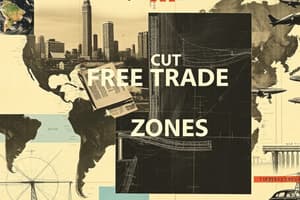Podcast
Questions and Answers
What is the fundamental concept behind Free Trade as presented in the lecture?
What is the fundamental concept behind Free Trade as presented in the lecture?
- Specialization and trading for non-specialized goods (correct)
- Increase government control over trade agreements
- Minimize exports to achieve economic growth
- Maximize tariffs to protect local industries
According to Adam Smith, which factors primarily contribute to a state's economic prosperity?
According to Adam Smith, which factors primarily contribute to a state's economic prosperity?
- Isolationist trade policies and low tariffs
- High taxation and strict regulations
- Investment in military and foreign ventures
- Peace, manageable taxes, and just governance (correct)
What are common barriers to trade mentioned in the lecture?
What are common barriers to trade mentioned in the lecture?
- Tariffs, quotas, and embargoes (correct)
- Direct negotiations and mutual agreements
- Technological innovations and market demand
- Cultural exchange and diplomatic relations
What was the outcome of the U.S. re-negotiation of NAFTA into USMCA?
What was the outcome of the U.S. re-negotiation of NAFTA into USMCA?
Which of the following factors is NOT emphasized as a root of economic prosperity in the lecture?
Which of the following factors is NOT emphasized as a root of economic prosperity in the lecture?
What is typically associated with the term 'dumping' in the context of international trade?
What is typically associated with the term 'dumping' in the context of international trade?
What is one of the primary arguments against free trade related to domestic economic concerns?
What is one of the primary arguments against free trade related to domestic economic concerns?
Which of the following products has NOT been reported in antidumping claims filed by U.S. producers?
Which of the following products has NOT been reported in antidumping claims filed by U.S. producers?
Which economic rationale suggests that a country should maintain military self-sufficiency?
Which economic rationale suggests that a country should maintain military self-sufficiency?
Which of the following is a significant concern regarding dumping in relation to consumer products?
Which of the following is a significant concern regarding dumping in relation to consumer products?
What is the primary function of tariffs in international trade?
What is the primary function of tariffs in international trade?
Which historical event serves as a lesson regarding the effects of protective trade policies?
Which historical event serves as a lesson regarding the effects of protective trade policies?
What does Adam Smith imply is essential for achieving high economic opulence?
What does Adam Smith imply is essential for achieving high economic opulence?
What are the potential implications of backing out of trade agreements such as NAFTA?
What are the potential implications of backing out of trade agreements such as NAFTA?
Which of the following factors is NOT a type of barrier to trade mentioned in the lecture?
Which of the following factors is NOT a type of barrier to trade mentioned in the lecture?
Flashcards
Free Trade
Free Trade
Specializing in producing goods and services where you have a comparative advantage, then trading for the rest.
Protectionism
Protectionism
Protecting domestic industries by limiting imports, typically via tariffs or quotas.
Smoot-Hawley Tariff Act
Smoot-Hawley Tariff Act
Historical US tariff act; highly protectionist, leading to a sharp decline in world trade during the Great Depression.
Barriers to Trade
Barriers to Trade
Signup and view all the flashcards
Balance of Trade
Balance of Trade
Signup and view all the flashcards
Arguments Against Free Trade
Arguments Against Free Trade
Signup and view all the flashcards
Dumping (in context of free trade)
Dumping (in context of free trade)
Signup and view all the flashcards
Examples of Dumped Goods
Examples of Dumped Goods
Signup and view all the flashcards
Infant Industry Argument
Infant Industry Argument
Signup and view all the flashcards
Military Self-Sufficiency
Military Self-Sufficiency
Signup and view all the flashcards
Comparative Advantage
Comparative Advantage
Signup and view all the flashcards
Opportunity Cost
Opportunity Cost
Signup and view all the flashcards
Tariffs
Tariffs
Signup and view all the flashcards
Embargo
Embargo
Signup and view all the flashcards
Study Notes
International Trade Lecture #1
- Free trade is contrasted to protectionism.
- The basic argument for free trade is: "Do what you do best and trade for the rest!"
- Free trade promotes specialization.
Roots of Economic Prosperity
- Private property (and its protection) is fundamental.
- Rule of law and political stability are essential.
- Adam Smith stated that peace, low taxes, and a just administration are crucial for prosperity.
Domestic vs. International Trade
- Logistics, customs regulations, religious practices, holidays, gender differences, currency, tax issues, government policies, communication/language, and work policies (age, hours, conditions) are all barriers to international trade.
Protect and Destroy: The Lesson of Smoot-Hawley
- The Smoot-Hawley Tariff Act of 1930 significantly impacted world trade.
- The act resulted in a contraction of world trade.
- The act's negative effect on the US Economy is evidenced in falling stock prices and the subsequent Great Depression.
U.S. Balance of Trade
- Data, likely from TradingEconomics.com and the Bureau of Economic Analysis (BEA), illustrate fluctuations in the U.S. balance of trade, potentially over a period of time. Values and exact dates of data fluctuations are not provided.
U.S. Imports
- China, Canada, Mexico, and other countries are significant suppliers of imports to the U.S.
- Percentage breakdowns of imports from various countries.
U.S. Exports
- Data likely from TradingEconomics.com and the Bureau of Economic Analysis (BEA), displaying export data and potentially showing proportions of exports from different countries.
Arguments Against Free Trade
- Job losses, unfair trade practices (dumping), and the need for government protection of specific industries like military or infant industries.
Dumping
- Dumping is a common practice by foreign suppliers where they sell goods at lower prices than usual, sometimes to unfairly compete.
Products "Dumped"
- Various goods imported into the United States and often associated with dumping.
Remittances to Mexico
- Money sent back to Mexico by workers abroad.
- The value of remittances is significant (billions of dollars), a major source of foreign currency for Mexico.
- Data for remittances from 2020 to the present are available.
What's a Foreign Car?
- Parts and assembly locations in international trade.
- Questions regarding production, parts origins, and profits.
Studying That Suits You
Use AI to generate personalized quizzes and flashcards to suit your learning preferences.




